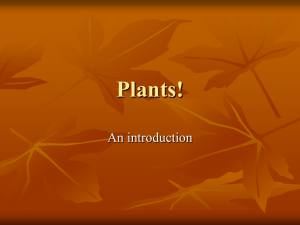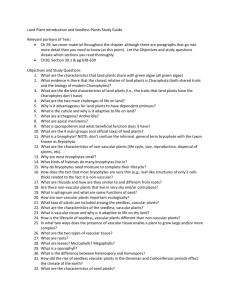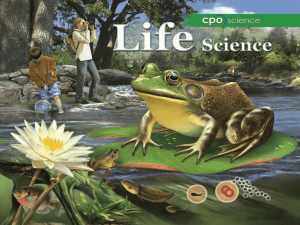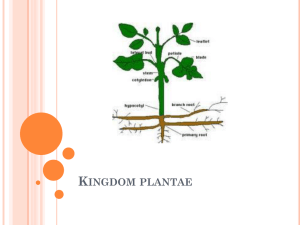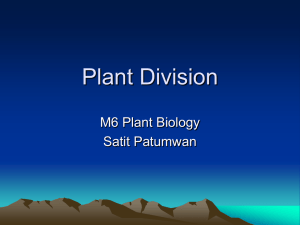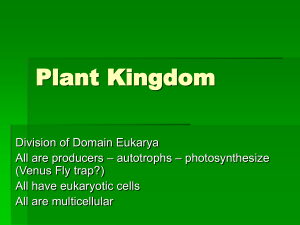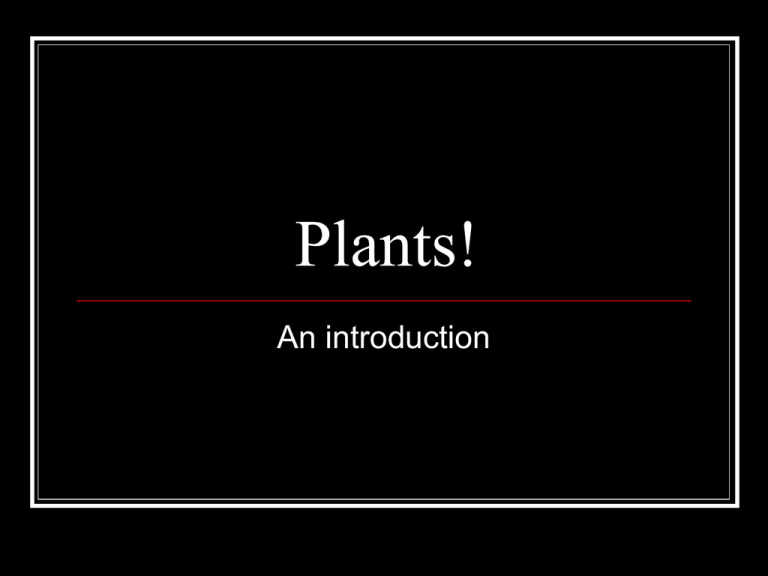
Plants!
An introduction
Plants
All plants are multi-cellular, autotrophic
eukaryotes.
Lots of cells.
Produces its own food using chlorophyll.
Has a Nucleus .
Plants
Plants are not able to independently move
from one place to another.
Plants have dedicated tissues
Groups of cells to perform specific functions.
All plants undergo sexual reproduction
Plant reproduction
All plants undergo sexual reproduction
involving fertilization producing a zygote
Fertilized egg.(seeds)
All plants have life cycles which alternates
between a gametophyte and a sporophyte.
Gametes - sex cells
Plant reproduction
The sporophyte produces spores by
meiosis.
In flowering plants, the sporophyte
comprises the whole body except the
pollen and seeds.
Plant reproduction
A gametophyte is the structure, or phase,
that contains a single set of chromosomes.
In flowering plants there are the female
gametophyte (ovule) and the male
gametophyte (pollen) structures.
Plant reproduction
http://8e.devbio.com/article.php?ch=20&id=268
Plant reproduction
apbiosemonefinalreview.pbworks.com
Plant reproduction
http://8e.devbio.com/article.php?ch=20&id=268
Plants
The plant kingdom is one of the largest
groups of living things with more than half a
million different species.
Examples include: multi-cellular algae, moss,
ferns, flowering plants, and trees.
Plant Classifications
There are only 4 distinct types of plants.
Non-vascular seedless plants
Vascular seedless
Vascular non-flowering (like pine cones)
Vascular flowering
Plant Classifications
Non-Vascular Seedless
Plants that do not use a system of vessels to
transport water and nutrients between different
parts of the plant.
Non-vascular plants are the simplest of all land
dwelling plants.
All are low-growing.
First plants on land.
Plant Classifications
Non-Vascular Seedless
Mosses
http://visual.merriam-webster.com/images/plants-gardening/plants/moss/examples-mosses.jpg
Moss Structure
Diagram modified from:
http://bryophytes.science.oregonstate.edu/page3.htm#anc
hor30816
Plant Classifications
Non-Vascular Seedless
Liverworts
http://www.sheffield.ac.uk/content/1/c6/05/24/91/liverworts-close-up-web.jpg
Plant Classifications
Non-Vascular Seedless
Hornworts
http://www.ucmp.berkeley.edu/plants/hornwortyoung.jpg
Plant Classifications
Seedless, Vascular
The plants in this group have a true vascular
transport system for the movement of water and
nutrients
They are "seedless" because they reproduce by
means of spores.
Spore
a reproductive structure that is adapted for dispersal.
Plant Classifications
Seedless, Vascular
Ferns
http://kmacphoto.net/ferns.jpg
Structure of a Fern
http://nefern.info/topics/tpcfrond.htm
Plant Classifications
Seedless, Vascular
Horsetails
http://www.library.illinois.edu/vex/toxic/hrstail/6-29-19.jpg
Plant Classifications
Seedless, Vascular
Whisk Ferns
http://www.palaeos.com/Plants/Images/Psilotum.jpg
Plant Classifications
Seeds, Vascular
Include conifers and flowering plants,
Plants have vascular transport system and
produce seeds.
Plant Classifications
Seeds, Vascular flowering
Angiosperms
http://www.biology.iastate.edu/Courses/211L/Anthoph/floweringplant
Angiosperm Life Cycle
tutorvista.com
Angiosperm Life Cycle
Parts of a seed.
http://extension.missouri.edu/p/MG3
Plant Classifications
Seeds, Vascular Non-flowering
Gymnosperms
http://biology.clc.uc.edu/graphics/taxonomy/plants/spermatophyta/Gymnosperms/
Gymnosperm Life Cycle
tutorvista.com
Gymnosperm Life Cycle
Parts of a cone.
Parts of a Plant
LEAF
Absorbs sunlight for plant to convert to energy.
Stores chlorophyll and is the site of photosynthesis.
Contain Stoma
a pore, found in the leaf and stem of plants that is used for
gas exchange
Can be wide and flat (as in a maple leaf) or long and thin
(as in a cactus spine)
Covered with a water proof layer called the cuticle
Parts of a Plant
LEAF
http://www.woodlands.co.uk/images/treeidentification/leafdiagram.jpg
Parts of a Plant
LEAF
http://www.molecularexpressions.com/cells/
leaftissue/images/leafstructurelargefigure1.jpg
Parts of a Plant
STEM
supports leaves and flowers.
carries water, minerals, and food up and down between
the plant’s leaves and roots.
can be small and thin (as in a flower) or tall and thick (as
in a tree).
helps plant grow in a direction toward energy sources.
has light-sensitive tips to ensure growth toward light.
Parts of a Plant
STEM
http://paintthelight.net/BotanyProject/Activities/images/2004_gallery_stem_diagram.jpg
Parts of a Plant
ROOT
Grows down into the soil or water.
Anchors plant to the earth.
Absorbs water and minerals needed for growth.
Includes varieties, based on structure:
Taproots: single large root with a few smaller, branching
roots.
Fibrous roots: many small roots branching off in different
directions.
Parts of a Plant
Taproot
http://upload.wikimedia.org/wikipedia/en/7
/7a/Plant_taproots.jpg
Parts of a Plant
Fibrous roots
http://www.croplangenetics.com/stellent/groups/public/documents/web_content/ecmd0014867.jpg
Parts of a Plant
Vascular System
Xylem
Used for water and mineral transport
Phloem
Used for sugar/food transport
Parts of a Plant
Vascular System
http://www.treeboss.net/images/bark_cross_section.jpg
Photosynthesis
Photosynthesis is the process by which
plants take energy from the sun and
combine carbon dioxide and water to
produce food.
Water + Carbon Dioxide + Light ---> Sugar + Oxygen
6H2O + 6CO2 + Light ---> C6H12O6 + 6O2
Photosynthesis
Utilizes Carbon dioxide from the air enters the
leaves through their stomata.
Water from the soil is absorbed through the roots.
Sunlight energy is absorbed through chlorophyll, found in
the leaves of most plants.
The chlorophyll uses the sun’s energy to split
water into hydrogen and oxygen. Hydrogen
combines with carbon dioxide to form glucose and
oxygen is released through the stomata.

